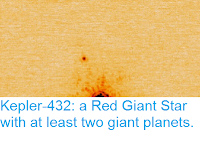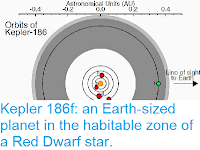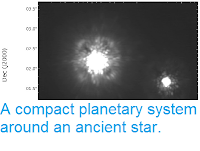M-type Stars (Red Dwarfs) are the most abundant type of stars in the galaxy, and are both smaller and longer lived than other types of stars. A number of recent studies have shown that many such stars are home to planetary systems, making them of great interest to planetary scientists. One recent discovery of particular not is the TRAPIST-1 system (formerly 2MASS J23062928-0502285), comprising a Red Dwarf Star (TRAPPIST-1A) 39.5 light years from Earth in the constellation of Aquarius, that has only 0.08 times the mass of the Sun, but which is surrounded by a system of six known planets (TRAPPIST-1 b, c, d, e, f, and g).
The system discovered in 2016 by the 2MASS (Two Micron All-Sky Survey) project, which combined data from telescopes at the Fred Lawrence Whipple Observatory on Mount Hopkins, Arizona and the Cerro Tololo Inter-American Observatory in Chile, and all six planets estimated to be of approximately Earth-mass, generating great deal of interest in the system, and therefore a desire on behalf of planetary scientists to gather further data on the system.
In a paper published on the arXiv database at Cornell University
Library on 13 April 2017, Songhu Wang of the Department of Astronomy at Yale University, Dong-Hong Wu of the School of Astronomy and Space Science and Key Laboratory of Modern Astronomy and Astrophysics at Nanjing University, Thomas Barclay of the NASA Goddard Space Flight Center, and the University of Maryland, and Gregory Laughlin also of the Department of Astronomy at Yale University describe the results of a study of the TRAPPIST-1 system using data from the Kepler Space Telescope.
The Kepler Space Telescope was launched in March 2009, and was trained on a single area of sky, the Kepler Deep Field until May 2013, when the spacecraft malfunctioned and begun to spin on its axis. This did not however prevent the craft from gathering new data, despite the inability of astronomers to choose the telescope's targets. Between 15 December 2016 and 4 March 2017 the TRAPPIST-1 system fell within Kepler's field of view, enabling the telescope to gather data on this system.
Wang et al. took the Kepler observation data for the TRAPPIST-1 system and analysed the light curved produced by the system's planets passing in front of the star, in order to produce a new model of the TRAPPIST-1 system.
Based upon this data Wang et al. calculate that the innermost planet, TRAPPIST-1b, has an orbital period of 1.5 days, and orbits the star at an average distance of 0.011 AU, i.e. 1.1% of the distance at which the Earth orbits the Sun. They further calculate that planet has a mass 0.79 times that of the Earth, and a radius 1.086 times that of the Earth.
The second planet, TRAPPIST-1c, is calculated to have an orbital period of 2.4 days and orbit at an distance of 0.015 AU. This planet is estimated to have a mass 1.63 times that of the Earth, and a radius 1.056 times the Earth's.
The third planet, TRAPPIST-1d, is calculated to have an orbital period of 4.0 days and orbit at an distance of 0.021 AU. This planet is estimated to have a mass 0.33 times that of the Earth, and a radius 0.722 times the Earth's.
The fourth planet, TRAPPIST-1e, is calculated to have an orbital period of 6.1 days and orbit at an distance of 0.028 AU. This planet is estimated to have a mass 0.24 times that of the Earth, and a radius 0.918 times the Earth's.
Wang et al. took the Kepler observation data for the TRAPPIST-1 system and analysed the light curved produced by the system's planets passing in front of the star, in order to produce a new model of the TRAPPIST-1 system.
Based upon this data Wang et al. calculate that the innermost planet, TRAPPIST-1b, has an orbital period of 1.5 days, and orbits the star at an average distance of 0.011 AU, i.e. 1.1% of the distance at which the Earth orbits the Sun. They further calculate that planet has a mass 0.79 times that of the Earth, and a radius 1.086 times that of the Earth.
The second planet, TRAPPIST-1c, is calculated to have an orbital period of 2.4 days and orbit at an distance of 0.015 AU. This planet is estimated to have a mass 1.63 times that of the Earth, and a radius 1.056 times the Earth's.
The third planet, TRAPPIST-1d, is calculated to have an orbital period of 4.0 days and orbit at an distance of 0.021 AU. This planet is estimated to have a mass 0.33 times that of the Earth, and a radius 0.722 times the Earth's.
Orbits of the Trappist-1 planetary system. The yellow lines are 1000 planetary orbits drawn randomly from the converged Markov Chain in TTV dynamical ts. The blue points correspond to the location of the planets at the K2 initial epoch 2,457,738.3654. Further photometric transit follow-up is urgently needed to attain a precise understanding of the Trappist-1 system. Wang et al. (2017).
The fourth planet, TRAPPIST-1e, is calculated to have an orbital period of 6.1 days and orbit at an distance of 0.028 AU. This planet is estimated to have a mass 0.24 times that of the Earth, and a radius 0.918 times the Earth's.
The fifth planet, TRAPPIST-1f,
is calculated to have an orbital period of 12.4 days and orbit at an
distance of 0.045 AU. This planet is estimated to have a mass 0.36 times
that of the Earth, and a radius 1.045 times the Earth's.
The sixth planet, TRAPPIST-1f,
is calculated to have an orbital period of 6.1 days and orbit at an
distance of 0.028 AU. This planet is estimated to have a mass 0.57 times
that of the Earth, and a radius 1.127 times the Earth's.
See also...







